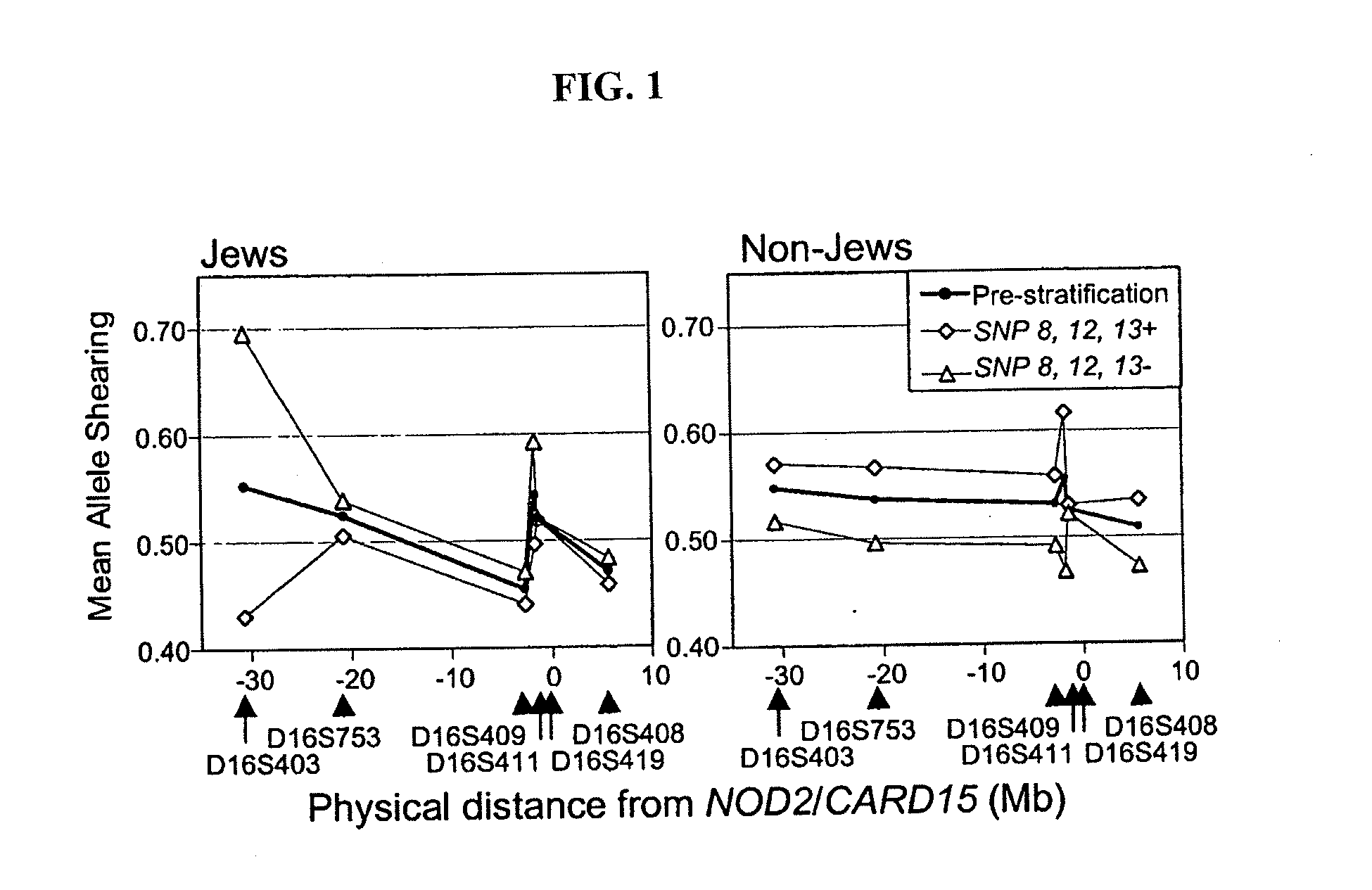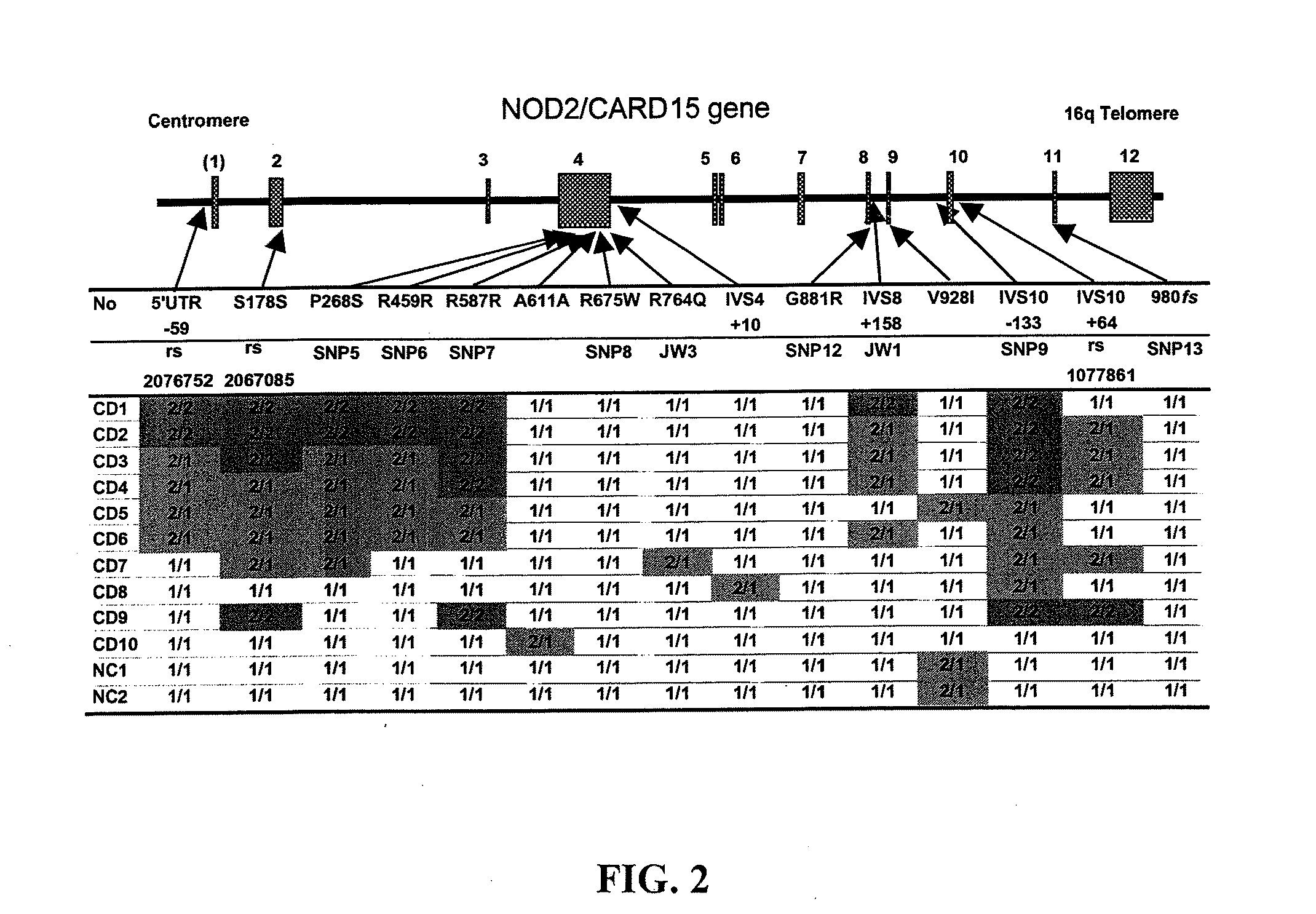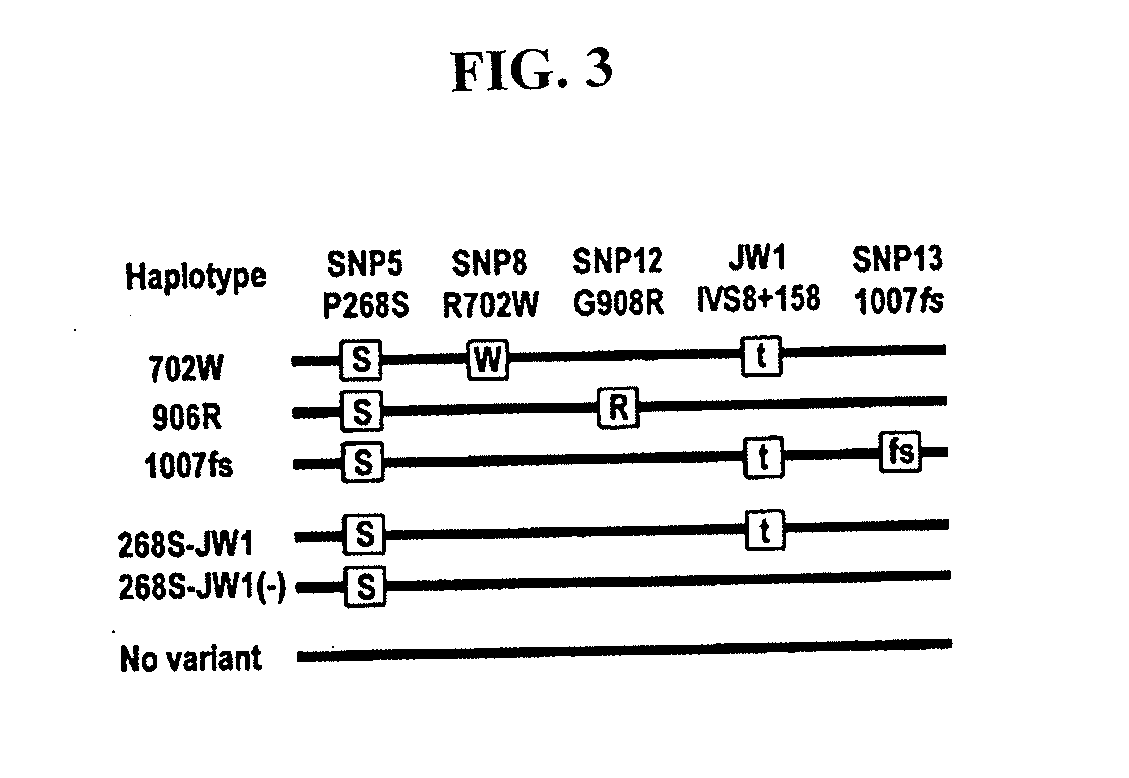Methods of using a nod2/card15 haplotype to diagnose crohn's disease
a technology of nod2/card15 and crohn's disease, applied in the field of autoimmunity and autoimmune diseases, can solve the problems of difficult diagnosis of crohn's disease from ulcerative colitis, increased risk of intestinal cancer in patients with ibd, and other types of inflammatory conditions of the bowel, so as to achieve diagnosis or predict susceptibility to crohn's disease
- Summary
- Abstract
- Description
- Claims
- Application Information
AI Technical Summary
Benefits of technology
Problems solved by technology
Method used
Image
Examples
example i
Stratification Linkage Analysis of Crohn's Disease Families Based on Three NOD2 / CARD15 SNPS
[0101]This example demonstrates that one or more unidentifiable disease-predisposing alleles at the IBD1 locus contribute to Crohn's disease in the Jewish population.
A. Selection of Study Subjects
[0102]A total of 211 Crohn's disease families (64
[0103]Ashkenazi-Jewish and 147 non-Jewish Caucasian families) consisting of 373 Crohn's disease patients and 672 unaffected relatives were studied. The probands of all families were ascertained from the IBD Center at Cedars-Sinai Medical Center or referred to Cedars-Sinai Medical Center by gastroenterologists or the Crohn's Colitis Foundation of America nationwide. These families had at least one family member affected with Crohn's disease and did not have any known individuals affected with ulcerative colitis. In these 211 families, 91 multiplex Crohn's disease families that included Crohn's disease sib-pairs were available for linkage analysis (28 Ash...
example ii
Association of NOD2 / CARD15 Single Nucleotide Polymorphisms with Crohn's Disease
[0110]This example describes the association of NOD2 / CARD15 SNPs with Crohn's disease in an Ashkenazi Jewish population.
A. Transmission Disequilibrium Test (TDT)
[0111]A family based association test was performed using a transmission disequilibrium test (TDT; Spielman et al., “Transmission test for linkage disequilibrium: the insulin gene region and insulin-dependent diabetes mellitus (IDDM),”Am. J. Hum. Genet. 52:506-516 (1993)) to investigate any ethnic based differences of Crohn's disease association by the three principal NOD2 / CARD15 SNPs. For this analysis, the 64 Jewish and 147 non-Jewish families were used as the sample. The analysis confirmed that the SNP8, SNP12, and SNP13 variants almost always occur on a common background haplotype which includes the 268S allele (“286S alone haplotype”), and that the SNP8, SNP12, and SNP13 variants were never found on the same haplotype in both family groups.
[0...
example iii
Identification of Novel NOD2 / CARD15 Disease Predisposing Mutations in Individuals of Ashkenazi Jewish Descent
[0116]This example describes identification of twelve NOD2 / CARD15 sequence variants in individuals of Ashkenazi Jewish descent.
[0117]To search for disease predisposing mutations on the 268S alone haplotype in the Jewish population, NOD2 / CARD15 genes, including exons, 5′ untranslated regions (UTR) and splicing signal regions, were sequenced from twelve Jewish individuals. Genomic DNA was obtained from twelve individuals of Ashkenazi descent. These individuals consisted of seven Crohn's disease patients with the 268S alone haplotype (CD1-CD7 in FIG. 2), and three patients (CD8-CD10) and two normal controls (NC1 and NC2) without the 268S variant allele. As shown in FIG. 2, 12 sequence variants in NOD2 / CARD15 were identified. One of these, an intervening sequence variant, IVS8+158, is a C to T mutation in the palindrome sequence within intron 8 and was designated “JW1”. Another, ...
PUM
| Property | Measurement | Unit |
|---|---|---|
| weight loss | aaaaa | aaaaa |
| MASs | aaaaa | aaaaa |
| haplotype structure | aaaaa | aaaaa |
Abstract
Description
Claims
Application Information
 Login to View More
Login to View More - R&D
- Intellectual Property
- Life Sciences
- Materials
- Tech Scout
- Unparalleled Data Quality
- Higher Quality Content
- 60% Fewer Hallucinations
Browse by: Latest US Patents, China's latest patents, Technical Efficacy Thesaurus, Application Domain, Technology Topic, Popular Technical Reports.
© 2025 PatSnap. All rights reserved.Legal|Privacy policy|Modern Slavery Act Transparency Statement|Sitemap|About US| Contact US: help@patsnap.com



